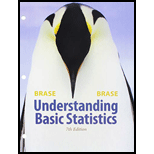
Concept explainers
Please provide the following information for Problems 11-22. part (a):
(i) What is the level of significance? State the null and alternate hypotheses.
(ii)Check Requirements What sampling distribution will you use? What assumptions are you making? What is the value of the sample test statistic? Compute the corresponding z or t value as appropriate.
(iii)Find (or estimate) the P-value. Sketch the sampling distribution and show the area corresponding to the P-value.
(iv)Based on your answers in parts (i)—(iii), will you reject or fail to reject the null hypothesis? Are the data statistically significant at level a?
(v)Interpret your conclusion in the context of the application.
Note: For degrees of freedom d.f. not in the Student's t table, use the closest d.f. that is smaller. In some situations, this choice of d.f. may increase the P-value a small amount, and therefore produce a slightly more “conservative” answer. Answers may vary due to rounding.
Crime Rate: FBI A random sample of
| 3.5 | 3.7 | 4.0 | 3.9 | 3.3 | 4.1 | 1.8 | 4.8 | 2.9 | 3.1 |
Another random sample of
| 3.7 | 4.3 | 4.5 | 5.3 | 3.3 | 4.8 | 3.5 | 2.4 | 3.1 | 3.5 | 5.2 | 2.8 |
(Reference: Crime in the United States, Federal Bureau of Investigation.) Assume that the crime rate distribution is approximately normal in both regions. Use a calculator to verify that
(a) Do the data indicate that the violent crime rate in the Rocky Mountain region is higher than that in New England? Use
(b) Find a 98% confidence interval for
Want to see the full answer?
Check out a sample textbook solution
Chapter 10 Solutions
Bundle: Understanding Basic Statistics, Loose-leaf Version, 7th + WebAssign Printed Access Card for Brase/Brase's Understanding Basic Statistics, ... for Peck's Statistics: Learning from Data
 Glencoe Algebra 1, Student Edition, 9780079039897...AlgebraISBN:9780079039897Author:CarterPublisher:McGraw Hill
Glencoe Algebra 1, Student Edition, 9780079039897...AlgebraISBN:9780079039897Author:CarterPublisher:McGraw Hill College Algebra (MindTap Course List)AlgebraISBN:9781305652231Author:R. David Gustafson, Jeff HughesPublisher:Cengage Learning
College Algebra (MindTap Course List)AlgebraISBN:9781305652231Author:R. David Gustafson, Jeff HughesPublisher:Cengage Learning

